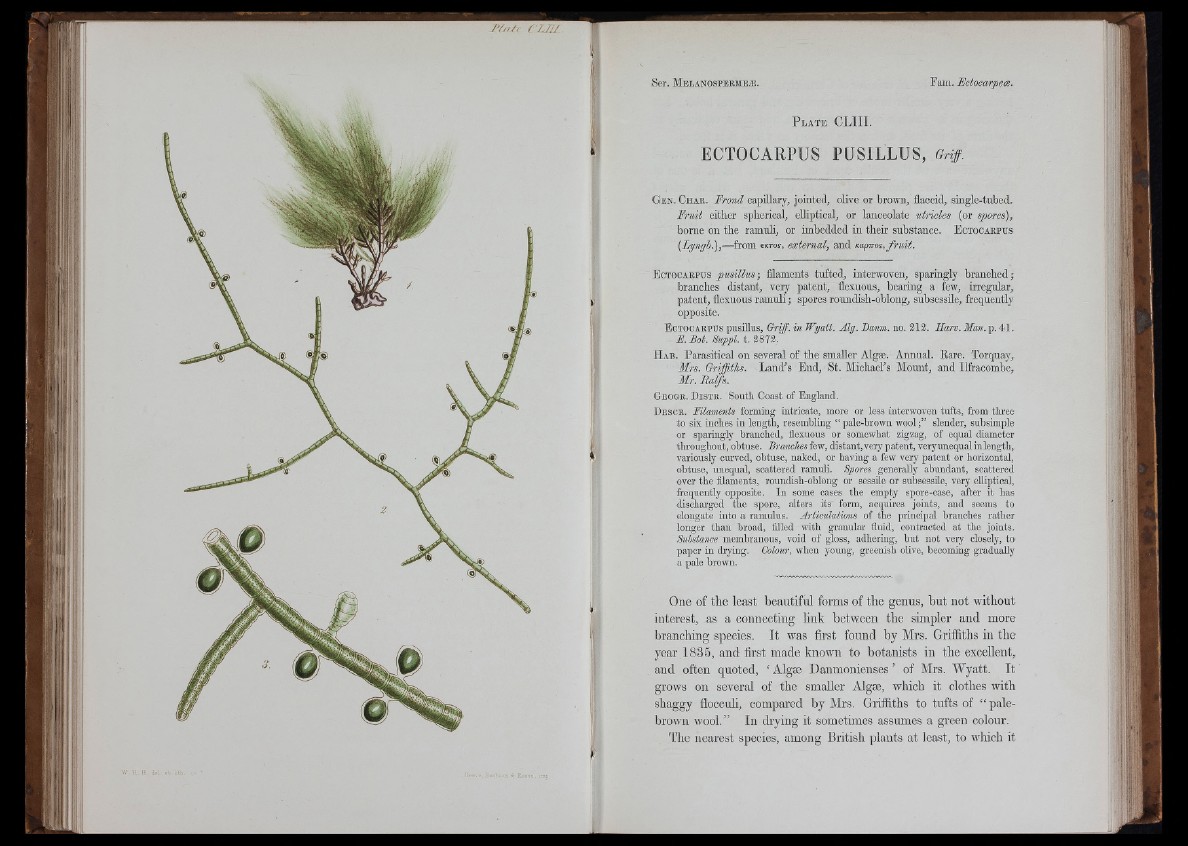
ii
r
H
I':
P l a t e CLIII.
ECTOCARPUS PUSILLUS, Griff.
G e n . C h a e . Frond capillary, Jomted, olive or brown, flaccid, single-tnbed.
F ru it either splierical, elliptical, or lanceolate utricles (or spores),
borne on the ramiJi, or imbedded in their substance. E o t o o a e p u s
[Lyngh.),—from cktos, external, and Kapnros, f r u i t .
E o t o o a e p u s pusillus-, filaments tufted, interwoven, sparingly branched;
branches distant, very patent, flexuous, bearing a few, irregular,
patent, flexuous ramuli; spores roundish-oblong, subsessile, frequently
opposite.
E ctocarpus pusillus, Griff, in Wyatt. Alg. Banm. no. 313. Harv. Man. p. 41,
E. Bat. Suppl. t. 3873.
H a b . Parasitical on several of the smaller Algae. Annual. Bare. Torquay,,
Mrs. Griffiths. Land’s End, St. Michael’s Mount, and Ilfracombe,
M r. R alfs.
Geoge. D is t r . South Coast of England.
DESi!R. Filaments forming intricate, more or less interwoven tufts, from three
to six inches in length, resembling “ pale-brown w o o ls le n d e r , snbsimple
or sparingly branched, flexuous or somewhat zigzag, of equal diameter
throughout, obtuse. Branches few, distant, very patent, very unequal inlength,
variously curved, obtuse, naked, or having a few very patent or horizontal,
obtuse, unequal, scattered ramuli. Spores generally abundant, scattered
over the filaments, roundish-oblong or sessile or subsessile, very eUiptical,
frequently opposite. In some cases the empty spore-case, after it has
discharged the spore, alters its form, acquires joints, and seems to
elongate into a ramulus. Articulations of the principal branches rather
longer than broad, filled with granular fluid, contracted at the joints.
Substance membranous, void of gloss, adhering, but not very closely, to
paper in drying. Colour, when young, gi-eenish olive, becoming gradually
a pale brown.
One of the least beautiful forms of the genus, but not without
interest, as a connecting link between the simpler and more
branching species. It was first found by Mrs. Griffiths in the
year 1835, and first made known to botanists in tbe excellent,
and often quoted, ‘ Algae Danmonienses ’ of Mrs. Wyatt. It
grows on several of the smaller Algae, which it clothes with
shaggy flocculi, compared by Mrs. Griffiths to tufts of “ pale-
brown wool.” In drying it sometimes assumes a green colour.
I'ho nearest species, among British plants at least, to which it